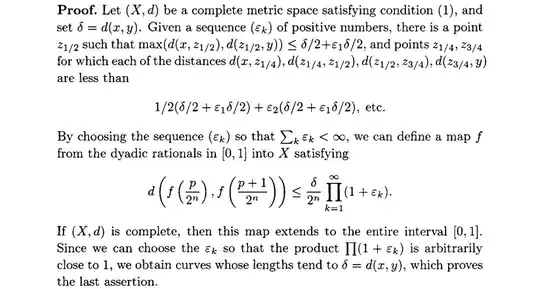For $(1)$: Let's first follow the author's pattern. Begin with $\delta=d(x,y)$. We know for any chosen $\kappa>0$ there is $z_{1/2}$, $d(x,z_{1/2})\le\frac{1}{2}\delta+\kappa$. The author sees fit to pick $\kappa=\frac{1}{2}\delta\epsilon_1$ here; then we have $d(x,z_{1/2})\le\frac{1}{2}\delta+\frac{1}{2}\delta\epsilon_1$ (and the same for $d(y,z_{1/2})$). Ok, with the new "$d(x,y)$" term being $d(x,z)$ we can find $z_{1/4}$ with $d(x,z_{1/4})\le\frac{1}{2}d(x,z)+\kappa\le\frac{1}{2}(\delta/2+\epsilon_1\delta/2)+\kappa$ where we are again free to choose $\kappa>0$; the author wants to choose $\kappa=\frac{1}{2}\epsilon_2\cdot(\delta/2+\epsilon_1\delta/2)$. Note: that means we can now write $d(x,z_{1/4})\le\left(\frac{1}{2}+\epsilon_2\right)\left(\frac{1}{2}\delta+\epsilon_1\cdot\frac{1}{2}\delta\right)$ (and the same bounds for e.g. $d(z_{1/4},z_{1/2})$). To continue the induction, I know I can find $z_{1/8}$ with $d(x,z_{1/8})\le\frac{1}{2}d(x,z_{1/4})+\kappa$. How do I choose $\kappa$? I choose it to be $\frac{1}{2}\epsilon_3\cdot\text{ the previous bound }$. Then: $$d(x,z_{1/8})\le\frac{1}{2}\left(\left(\frac{1}{2}+\epsilon_2\right)\left(\frac{1}{2}\delta+\epsilon_1\cdot\frac{1}{2}\delta\right)\right)+\frac{1}{2}\epsilon_3\cdot\underset{\text{the previous bound}}{\underbrace{\left(\left(\frac{1}{2}+\epsilon_2\right)\left(\frac{1}{2}\delta+\epsilon_1\cdot\frac{1}{2}\delta\right)\right)}}\\=\left(\frac{1}{2}+\epsilon_3\right)\left(\frac{1}{2}+\epsilon_2\right)\left(\frac{1}{2}\delta+\epsilon_1\cdot\frac{1}{2}\delta\right)$$Ok. I can then find $z_{1/16}$ and pick $\kappa=\frac{1}{2}\epsilon_4\cdot\text{ the previous bound on $d(x,z_{1/8})$}$. Then $d(x,z_{1/16})\le(\frac{1}{2}+\frac{1}{2}\epsilon_4)\cdot\text{ the previous bound }=(\frac{1}{2}+\frac{1}{2}\epsilon_4)(\frac{1}{2}+\frac{1}{2}\epsilon_3)(\frac{1}{2}+\frac{1}{2}\epsilon_2)(\frac{1}{2}\delta+\epsilon_1\frac{\delta}{2})$. Et cetera.
It's now hopefully clear we can choose the $z_{m/2^n}$ such that $d(z_{m/2^n},z_{(m+1)/2^n})\le\left(\frac{\delta}{2}+\frac{\epsilon_1\delta}{2}\right)\left(\frac{1}{2}+\epsilon_2\right)\cdots\left(\frac{1}{2}+\epsilon_n\right)$ for all $n$, and then it's easy to bound this by $\frac{\delta}{2^n}\prod_{j=1}^\infty(1+\epsilon_j)$.
Your pattern of choosing each $k$th "$\kappa$" to be $\epsilon\cdot 2^{-2k}$ where $\epsilon>0$ is some fixed initial constant works just fine. Under these choices, it's easy to prove by induction that, if we denote the $k$th bound as $\delta_k$ - starting from $\delta_0=\delta=d(x,y)$ - we have: $$\delta_k=2^{-k}\cdot d(x,y)+\epsilon\cdot\sum_{j=k+1}^{2k}2^{-j}$$Then we can always have that: $d(x,z_{1/2^n}),d(z_{1/2^n},z_{2/2^n}),\cdots,d(z_{(2^n-1)/2^n},y)$ are all bounded by $2^{-n}\cdot(d(x,y)+\epsilon)$ using a geometric series.
For $(2)$: it's easy to deduce from the bound on $f$ that $f:\Bbb Q'\to X$ is uniformly continuous, where $\Bbb Q'$ denotes the metric space of dyadic rationals in $[0,1]$; since $[0,1]$ is the metric completion of $\Bbb Q'$, uniform continuity is well known to be a sufficient condition to lift $f$ to a unique continuous extension $f:[0,1]\to X$ (if $X$ is complete). This is to do with the fact that uniformly continuous maps preserve Cauchy sequences; your proposed argument can be made to work, but crucially rests on the uniform continuity.
What you also need to do, which you have have not mentioned in your post, is determine the continuity of this extended map. It’s not also not immediately immediate that the length of the resultant lift $f$ is bounded by $\delta\prod_{j=1}^\infty(1+\epsilon_j)$, you have to do some fiddling and use the fact $f$ is uniformly continuous.

